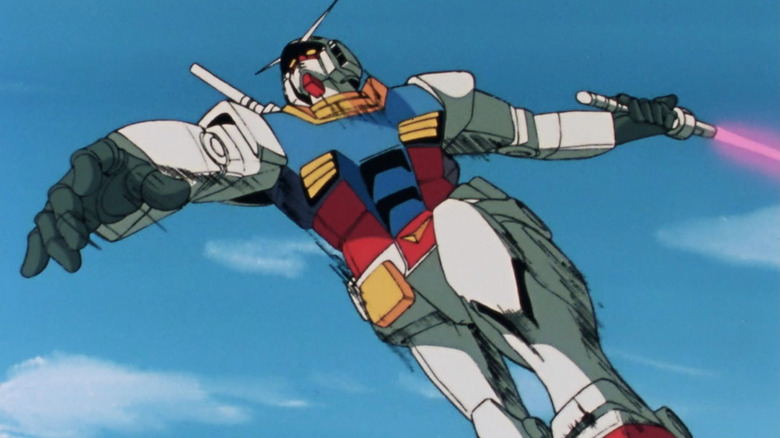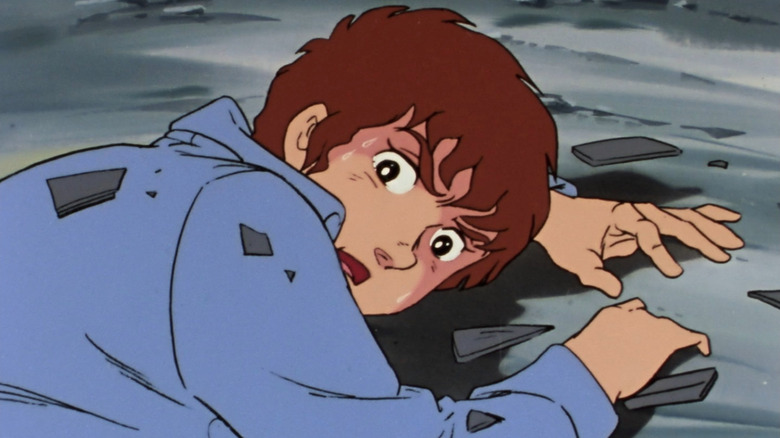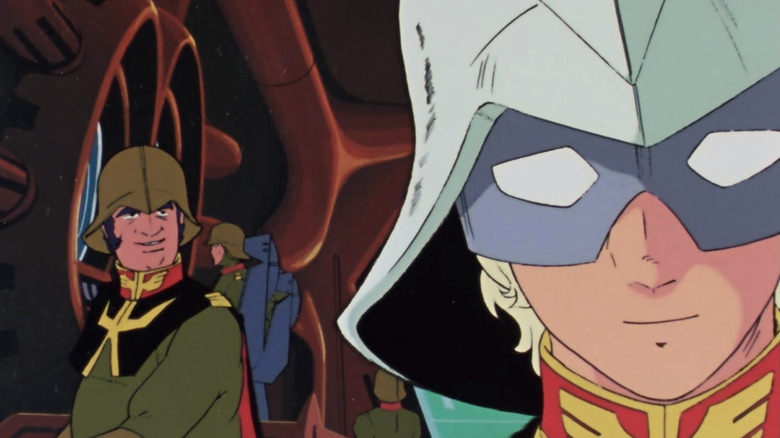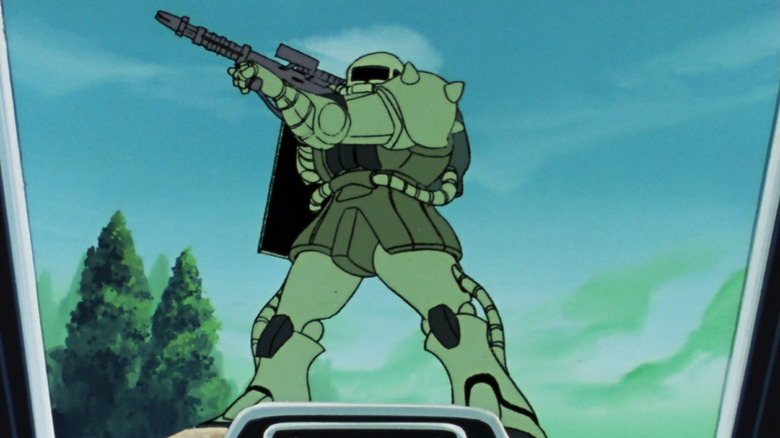The Daily Stream: Mobile Suit Gundam Is The Grandaddy Of Giant Robots
(Welcome to The Daily Stream, an ongoing series in which the /Film team shares what they've been watching, why it's worth checking out, and where you can stream it.)
The Series: "Mobile Suit Gundam"
Where You Can Stream It: Funimation
The Pitch: Civilian teen Amuro Ray becomes the pilot for a prototype mobile suit, or manned robot, defending the Earth Federation and its space colonists from the forces of Zeon.
In "Mobile Suit Gundam," the operative word is sensō (war). Yoshiyuki Tomino's groundbreaking 1979 mecha anime series is a sci-fi war epic, grounded in practical human concerns. It just happens to involve giant robots.
Though its loud primary color scheme shows the vestiges of previous "super robots" like Mazinger Z, the RX-78-2 Gundam — piloted by young Amuro — turned the tide of anime toward a more realistic vision of mechs as military machines. Going forward, the new breed of "real robots" would be weapons of war, fighting each other and sometimes kaiju.
As someone who was first exposed to anime through "Neon Genesis Evangelion" and who first embraced Guillermo del Toro's work through "Pacific Rim," I never realized the extent to which this franchise influenced them both until I watched "Mobile Suit Gundam." While Gundam iconography has permeated pop culture the way Godzilla iconography has (it was a big moment, for instance, when Gundam showed up to fight Mechagodzilla in Steven Spielberg's "Ready Player One"), the King of Monsters is live-action. And I'd venture to say that, outside anime fandom, fewer people have seen a Gundam movie than a Godzilla movie.
Yet Gundam remains one of the world's most lucrative, prolific media franchises, with dozens of movies and TV shows, including the recent "Witch from Mercury" series, to consider. This immediately raises the question of where to even begin with it.
Why it's essential viewing
With "Mobile Suit Gundam," the sophisticated connoisseur of giant robots (and real-life statues of them, like Guillermo del Toro) can forego the starting-point dilemma and begin at the beginning. This is the original Gundam series that started it all. Forty-two episodes are available on Funimation (one more, the "lost" episode 15, was produced but never released stateside at Yoshiyuki Tomino's request), but beyond the intro and closing credits, there's only about 20 minutes to each episode. You could binge the entire series in the time it would take to watch one or two seasons of a longer, live-action drama.
Watching "Mobile Suit Gundam" is like entering a '70s time warp. Some of the music and animation, like the opening theme song and the three recurring orphan kids drawn in a cutesy style, may feel a bit dated, but there are also moments of high drama and character intrigue that still make this series a rewarding watch.
The first episode sees Amuro's space city being evacuated as cyclopean Zaku mechs from another rogue colony attack. Right from the start, we see bodies strewn on the battlefield, a girl left crying and holding her lifeless mother. The destruction of a shelter decimates civilians and soldiers alike, whereupon Amuro finds the blueprints for the Earth Federation's secret weapon (and mecha anime's future).
Per the title, Gundam itself isn't a character; it's a "mobile suit." It's not long before Amuro climbs in the cockpit and leaps into action, bisecting Zakus with his laser sword. The first "Star Wars" movie had introduced lightsabers to the world two years earlier, and while Darth Vader's helmet was itself inspired by the samurai kabuto, it's hard not to see an echo of it in the silver helmet of Amuro's famous adversary, Char Aznable.
From Gundam to Evangelion
The influence of "Mobile Suit Gundam" can't be overstated. The year before "Neon Genesis Evangelion" premiered on Japanese TV, creator Hideaki Anno (who worked as a mechanical designer on the "Char's Counterattack" film), interviewed Yoshiyuki Tomino for Animage magazine. Anno later wrote an essay, translated by Melissa Tanaka for volume 1 of the "Mobile Suit Gundam: The Origin" manga, where he self-identified as a "Gundam fan" and lamented that "the legacy of Gundam has dwindled down to the mobile suits." Culture vultures know the sight of this "weapon bearing the elements of a character," as Anno called Gundam, but the human travails of Amuro Ray and other characters have been overshadowed by the giant robot.
In "Mobile Suit Gundam," Amuro's own mother calls him a disgraceful child, and some modern viewers might see him the same way. While less pitiful than Shinji Ikari in "Evangelion," Amuro is a no less flawed protagonist who's just as inclined to go into berserker mode on the battlefield, then come back to his quarters and curl up in bed, disconsolate in his loneliness.
There's a clear through line from Amuro, whose aloof father is the chief military engineer behind the development of Gundam, to Shinji, whose aloof father is a scientist and the commander of NERV, the organization responsible for the Evangelion units. Both protagonists are teen mech pilots, born to mech builders, and both lack confidence as they respond to the pressures of duty.
The bridge of White Base in "Mobile Suit Gundam" becomes the Nerv HQ command center in "Neon Genesis Evangelion," where talk of "sorties" continues in the control room and even the music sounds similar. Compare Takeo Watanabe and Yūshi Matsuyama's "Danger" from "Mobile Suit Gundam" with Shirō Sagisu's "Angel Attack" from "Neon Genesis Evangelion."
The true star war
In the cockpit, Amuro sweats bullets, his voice quavering. It's only by the grace of Gundam and its smart computer that he's able to survive. The Gundam stores combat case studies in its memory, so even though Amuro, the child soldier, is outmatched by the more experienced Char, he can learn as he goes.
Meanwhile, the masked Char — known as the Red Comet in his custom Zaku — remains enigmatic in his propensity for backstabbing. Char's storyline is complicated by the arrival of his old friend Garma Zabi, who belongs to Zeon's ruling family. The elder brother, Gihren, emerges as a Hitlerian dictator, bent on space conquest with the cry "Sieg Zeon!"
Needless to say, Japan's postwar animators helped make "Mobile Suit Gundam" much more than a Saturday-morning cartoon. Characters regularly die onscreen, burning up on reentry into earth's atmosphere or going on kamikaze runs, shouting, "Glory to Zeon!" instead of the stereotypical "Banzai!" At times, lines of morality get blurred, like when an enemy patrol craft delivers food to a mother and child, only for Gundam to shoot it down. The woman observes that no matter who wins the war, it will just leave more widows like her.
Early on, Amuro helps lead a ship full of refugees to safety, but instead of giving him a hero's welcome, the Earth Federation wants to court martial him for misappropriating classified military technology. As in "Space Battleship Yamato," some of his battles are fought in orbit, but Amuro insists the Gundam is a ground weapon.
The same could be said of "Mobile Suit Gundam." Despite its premature ending due to cancellation, this remains one of the great anime series, a militarized space robot saga that keeps its giant mech legs planted firmly astride the human cost of war.



